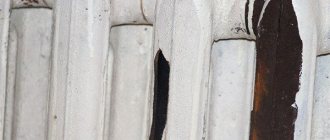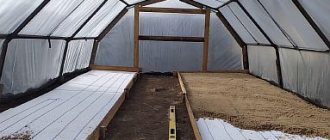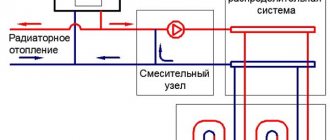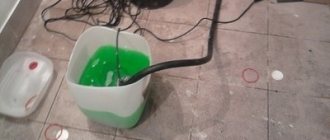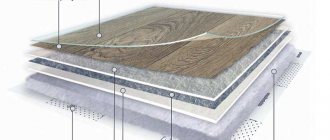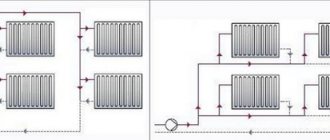Coolant "Warm House" is an inexpensive, non-hazardous and high-quality composition intended for heating systems. In addition, it is not only able to protect the equipment used, but also a safe, environmentally friendly product. It contains protective components that increase its ability to resist scale formation, there is almost no foam formation and the composition is able to slow down corrosion.
Pros and cons of the product
It has the following properties:
- The operating temperature difference ranges from -30 to +106 degrees;
- The working life of the fluid is about 5 years;
- Safe for flax , paronite, rubber, plastic and metal-plastic, eliminating possible leaks;
- Safe substance for humans and animals;
- If the coolant is used only for heating , then its service life increases to 10 years;
- Explosion- and fireproof liquid.
Among the shortcomings it is worth mentioning the following:
- Inability to use electrolysis colas when heating a room;
- The presence of salt in the composition increases corrosion;
- It is necessary to use a composition designed for one of the operating temperatures. The use of a coolant with unsuitable temperature characteristics increases the possibility of glycol deposits forming, which threatens the failure of heating elements and the appearance of resinous deposits;
- Dilution of the “Warm House” composition with other liquids without testing may cause decomposition of additives and reduce the ability of the composition to resist corrosion.
Characteristics and types of coolant
The following brands of coolant are produced:
- “Warm House ECO-20” is an antifreeze made from propylene glycol. Ideal for dual-circuit heating devices;
- “Warm House -30” is an antifreeze made from ethylene glycol, used for heating with single-circuit boilers, but it is also suitable for other designs. When filling systems of double-circuit and tensile boilers, dilution is required;
- “Warm House ECO-30” is made from propylene glycol. When filling systems of double-circuit and tensile boilers, dilution is required;
- “Warm House -65” is a high-concentration composition made from ethylene glycol.
Completely prepared formulations are already diluted to the required concentration.
“Warm House -65” - high concentration composition, produced from ethylene glycol
Composition of the coolant "Warm Home - ECO"
The basis of antifreeze is pharmacological grade propylene glycol. This liquid is green in color and contains fluorescein, which makes it easier to find leaks. The coolant “Warm House - ECO” is designed for use as part of heating and air conditioning systems. The operating temperature of the fluid ranges from –30 to 106 °C. This makes it suitable for use in double-circuit boilers, as well as in facilities with high environmental safety requirements.
The coolant "Warm House - ECO" contains a package of additives that serve to protect against scale, foam formation, and corrosion. The manufacturer does not recommend using this composition in systems with galvanized pipes due to the likelihood of sediment formation. In addition, care must be taken to seal the system - this is due to the high fluidity of the composition. Before putting the circuit into operation, it is recommended to perform preliminary pressure testing.
Product range
| “Warm House - ECO” is a high-quality propylene glycol-based coolant, designed for use in single-circuit and double-circuit boilers. This composition is environmentally friendly and does not have a corrosive effect on brass, copper, steel, cast iron and aluminum alloys, as well as solder. The manufacturer allows the presented coolant to be diluted with water. | Price: 899 rub. Order |
| “Warm House - ECO” is an environmentally friendly coolant that contains propylene glycol. The product is designed for use in single-circuit and double-circuit boiler equipment. Like other coolants under the “Warm House” brand, the composition is safe for aluminum, copper, cast iron, steel and aluminum parts. | Price: 1750 rub. Order |
| “Warm House - ECO” is the optimal solution for single-circuit and double-circuit boilers. The presented coolant has high performance and is environmentally friendly. The propylene glycol contained in the composition is safe for most materials, including polymers and metals. The offered product is supplied in larger volume containers that can hold 50 liters of liquid. | Price: 4350 rub. Order |
Application of compositions
The coolant of this brand is a liquid and is more fluid than water. For this reason, it is necessary to install the heating efficiently, after which the system must be pressure tested. Do not forget that it is prohibited to pour this liquid into electrolysis boilers.
Before use, most “Warm House” compositions are diluted with technical or distilled water. After dilution by 10%, its crystallization temperature increases to -25 degrees; if you dilute it to 20%, the characteristics of the solution will change to -20 degrees. After some time of operation, the coolant will begin to become jelly-like. If you dilute it with water at this time, the solution will restore its characteristics.
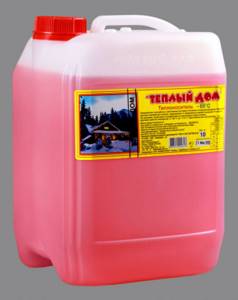
It is necessary to install the heating efficiently, after which the system must be pressure tested
Recipe for mixing 100 liters of coolant
“Warm Home” is often sold as a concentrate, which must be diluted before use. The proportions of the components affect the characteristics of the final solution (freezing point). If you add 23 liters of water to 77 liters of concentrate, the freezing point of the resulting solution will be about -40 degrees.
By dissolving 35 liters of water in 65 liters of concentrate, you will get a solution that can freeze only at -30 degrees. Adding 40 liters of water to 60 liters of concentrate will give you a mixture that will freeze at 25 degrees below zero. If the frost in your region is no more than 20 degrees, then you need to dilute 54 liters of concentrate with 46 liters of water.
In the equipment, all joints are treated with sealing compounds that are well resistant to the effects of glycol mixtures, or flax is used for this purpose. After the end of its service life, the solution still freezes only at low temperatures, but its anti-corrosion properties are significantly deteriorated.
For this reason, after the end of its useful life, the coolant must be drained and disposed of. Before filling the system with a new solution, be sure to check all components for leaks and completely flush the heating system.
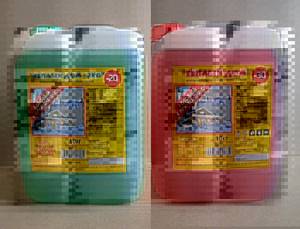
After the end of its service life, the solution still freezes only at low temperatures, but its anti-corrosion properties are significantly deteriorated
Operation and possible nuances
Compared to water, antifreezes have greater fluidity. Before using the liquid, you should carefully inspect all docking joints. Every part must be sealed. If you suspect a leak, professionals advise changing fastening parts and performing pressure testing of the equipment.
If you can’t make a replacement in the near future, you can use a sealant.
Recommendations for preparing the solution
Antifreeze can be diluted with ordinary water from a well, but in this case the content of salts and metals may be increased. To avoid difficulties, you should first mix a small amount of anti-freeze liquid with water. For dilution you need to use a transparent container . The resulting solution should be transparent and not contain any sediment. Mixing should be done before pouring antifreeze into the system in order to ensure the quality of the composition.
“Warm House” liquids do not lose their properties for a long time. A one-time filling will last for about 5 years (and sometimes more). After this, the coolant will be ineffective. If you do not replace it in time, you may encounter corrosion and scale. Before adding new fluid, you need to flush the system with water or a special solution.
When preparing a solution that will be used for the heating system, the recommended proportions should be observed.
The crystallization temperature depends on the ratio of ingredients. The concentration may be as follows:
- 77 liters of antifreeze per 23 liters of water - crystallization temperature is -40°C;
- 65 liters of coolant per 35 liters of water - freezing occurs at -30°C;
- 60 liters of non-freezing liquid per 40 liters of water - the temperature at which crystallization begins will be -25°C;
- 54 liters of liquid per 46 liters of water - crystallization temperature is -20°C.
Features of use
In some cases, the use of antifreeze can be dangerous. Before using antifreeze, you should study information that manufacturers do not provide. There are the following nuances of its use:
- In double-circuit boilers, antifreeze is gradually mixed with water. Contact of antifreeze liquid with skin will not bring any positive effect. The coolant should not be used for double-circuit boilers.
- In an open heating system, the use of antifreeze is unacceptable, since during operation the fumes will enter the air.
- Propylene glycol and ethylene glycol react with galvanizing. With such contact, harmful substances are released into the atmosphere.
- The heating solution is more viscous than water. To circulate it through the pipes, powerful sediment will be required.
- The heat transfer level of the concentrate is 30% less than that of ordinary water, so the radiator material must be thinner.
“Warm Home” solutions are high-quality heating fluids. However, before using them, you should carefully read the instructions for use. If you follow the recommendations, the antifreeze liquid will serve you well and for a long time.
Reviews
Plumber1979, Moscow We use “Warm House” -65 in our heating. It is often counterfeited, but if you buy it from a trusted store, you can hope that it will serve well. Convinced by my own experience.
Sarychev, Obninsk I pour this coolant into the heating myself. But my heating system is low temperature. The temperature is no more than 60 degrees (if it’s 20 outside). It works fine, for heating with temperatures up to 80 degrees, the additives will probably decompose. You must carefully read the certificates to determine the highest operating temperature it can be used. Please also note that heating elements are designed to work with water.
Egor, Kizil I purchased the “Warm House” composition - as soon as I filled the system with the pump, I immediately noticed that the gaskets were leaking. If you use water instead of coolant, then after it you need to tighten all the connections; it is a very fluid liquid. There are no complaints during operation; in winter, this mixture heated the house normally. When we left it for almost three weeks, it did not freeze.
Artem, Syktyvkar Installed an imported heating system and foreign pipes and fittings. But there was no longer enough money to buy 200 liters of imported coolant, so I used “Warm House”. The boiler works great with it, there are no system leaks.
Evgeniy, Pevek If you remember that new antifreeze needs to be added every 5-6 years, my decision to use this mixture will not surprise anyone - it is not very expensive and does not spoil the heating system. True, there is a slight doubt whether its freezing temperature will be enough for the northern regions.
Blitz tips
If you dilute the coolant with water from a well or well, which contains a lot of minerals, then it is advisable to dilute the mixture in a transparent container in order to notice the formation of sediment in time. Considering that in some regions the water is of very low quality, it is advisable in this case to use completely ready-made formulations.
Not recommended:
- Fill galvanized systems because sediment may form from the coolant as a result of a chemical reaction;
- Use the composition in heating with electrolysis boilers;
- Mixing “Warm House” with similar products may cause a decrease in performance properties and service life;
- Overheat the coolant.
The compositions “Warm House -30” and “Warm House -65” are produced only for technical purposes (it contains poisonous ethylene glycol). To prevent poisoning, this composition should not be allowed to get into drinking water or food. If it gets on the skin, the area must be washed well with soapy water.
"Warm House-ECO" is suitable as a refrigerant in food production. But this does not mean at all that, for example, you can drink it. All types of coolant are explosion-proof and do not support combustion.
If necessary, the coolant must be stored in an airtight container, inaccessible and protected from sunlight; they should not be placed near food products.
Features of antifreeze “Warm Home - ECO”

This fluid requires the use of glycol compatible sealants. It is allowed to use silky linen without oil paint. “Warm House - ECO” is not recommended to be mixed with antifreeze of other brands without first checking compatibility.
The shelf life of the proposed liquid is at least 5 years. It should be remembered that the durability of the coolant depends on a number of factors, including heating temperature. The composition should not be brought to a boil to avoid irreversible destruction of propylene glycol and the formation of additives. Intensive coolant circulation helps avoid overheating.
Antifreeze "Warm House - ECO" is safe for people and animals. This composition is approved for use as a refrigerant in the food industry. It is fire and explosion proof. In addition, the vapors generated when the refrigerant is heated are not toxic.




